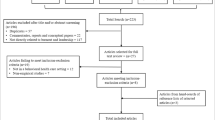Abstract
Six papers drawing on Hirschman's (1970) Exit, Voice, and Loyalty model are discussed with regard to two themes: (a) relationship to the original work (specifically focusing on variations in the definition and operationalization of the “loyalty” component), and (b) the development of the loyalty construct itself. A concerted effort is called for to pursue a better understanding of loyalty, including an improved appreciation of the depth and breadth of the construct, its antecedents and outcomes, and its operationalizations in organizational settings.
Similar content being viewed by others
References
Bennett, A. (1990).The Death of the Organization Man. New York: Morrow.
Canning, K. (1992). The voice of the loyal manager: Distinguishing attachment from commitment.Employee Rights and Responsibilities Journal, this issue.
Del Vecchio, G. (1991). A question of loyalty.Newsweek, September 23, pg. 8.
Farrell, D., & Rusbult, C. E. (1992). Exploring the exit, voice, loyalty, and neglect typology: The influence of job satisfaction, quality of alternatives, and investment size.Employee Rights and Responsibilities Journal, this issue.
Giacalone, R. A. (1990). Employee sabotage: The enemy within.Supervisory Management, 35(7), 6–7.
Graham, J. W., & Keeley, M. (1992). Hirschman's loyalty construct.Employee Rights and Responsibilities Journal, this issue.
Hirschman, A. O. (1970).Exit Voice, and Loyalty: Responses to Decline in Firms, Organizations, and States. Cambridge, MA: Harvard University Press.
Kelman, H. C., & Hamilton, V. L. (1989).Crimes of Obedience: Toward a Social Psychology of Authority and Responsibility. New Haven, CT: Yale University Press.
Kuhn, T. S. (1970).The Structure of Scientific Revolutions (2nd ed.). Chicago, IL: University of Chicago Press.
Ladd, J. (1967). Loyalty. In Edwards, P. (Ed.),The Encyclopedia of Philosophy Vol. 5 (pp. 97–98).
Leck, J., & Saunders, D. M. (1992). Hirschman's loyalty: Attitude or behavior?Employee Rights and Responsibilities Journal, this issue.
Mowday, R. T., Steers, R. M., & Porter, L. W. (1979). The measurement of organizational commitment.Journal of Vocational Behavior, 14, 224–247.
Navran, F. J. (1991). Silent saboteurs.Executive Excellence, 8(4), 11–13.
Sauders, D. M., Sheppard, B. H., Knight, V., & Roth, J. (1992). Employee voice to supervisors.Employee Rights and Responsibilities Journal, this issue.
Whyte, W. H., Jr., (1956).The Organization Man. New York: Simon & Schuster.
Withey, M. J., & Cooper, W. H. (1992). What's loyalty?Employee Rights and Responsibilities Journal, this issue.
Author information
Authors and Affiliations
Rights and permissions
About this article
Cite this article
Minton, J.W. The loyalty construct: Hirschman and beyond. Employ Respons Rights J 5, 273–281 (1992). https://doi.org/10.1007/BF01385053
Issue Date:
DOI: https://doi.org/10.1007/BF01385053




